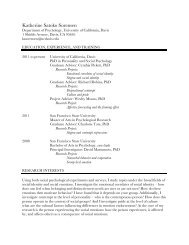The Psychology of Creativity:
The Psychology of Creativity:
The Psychology of Creativity:
You also want an ePaper? Increase the reach of your titles
YUMPU automatically turns print PDFs into web optimized ePapers that Google loves.
History <strong>of</strong> <strong>Creativity</strong> Research 12<br />
subjects. This tangential participation in creativity research is evident in the psychoanalytic, Gestalt, and behaviorist<br />
schools.<br />
Psychoanalysis<br />
Of the three schools just mentioned, the psychoanalytic is the most distinctive. It was the only one founded<br />
in the tradition <strong>of</strong> clinical science that arose at the end <strong>of</strong> the 19th century, and it was the only one that developed<br />
outside the research universities that provided the main venue for scientific inquiry. <strong>The</strong> central figure in this<br />
school, naturally, is its founder, Sigmund Freud. Despite the pride Freud had in his originality, his ideas did not<br />
spring up sans intellectual antecedents. Instead, he was firmly rooted in his times (Sulloway, 1979). From our<br />
standpoint, the most conspicuous circumstance is the fact that he was trained in the tradition just discussed. As a<br />
neurological pathologist, he had actually studied under Charcot, among others. It should not surprise us, therefore,<br />
that he viewed creativity and genius in a similar vein. This perspective is seen in the development <strong>of</strong><br />
psychobiography, an endeavor that he played a major role in developing. Indeed, Freud’s (1910/1964)<br />
psychoanalysis <strong>of</strong> Leonardo da Vinci is <strong>of</strong>ten seen as one <strong>of</strong> the seminal works in the field, notwithstanding its<br />
major flaws (Elms, 1988). <strong>The</strong> principal problem with psychobiographies <strong>of</strong> creative personalities is that they too<br />
frequently become “pathographies” (Runyan, 1982). That is, like Lombroso and James, creativity comes out <strong>of</strong><br />
some “sick soul” who is merely trying to cope with his or her psychological demons.<br />
Happily, psychobiography does not represent the only psychoanalytic input in creativity research (Gedo,<br />
1997). A more influential and perhaps more important contribution is the concept <strong>of</strong> “primary process” thinking.<br />
Primary process thought is more primitive than “secondary process” thought. Where the latter is devoted to<br />
conscious, logical, and realistic reasoning, the former is replete with fantasy, imagination, irrationality, and<br />
unconscious motives. Freud (1908/1959) explicitly compared creativity with daydreaming. In a sense, creators<br />
dream out loud, whether the dreams take place on a piece <strong>of</strong> paper, a canvas, or a block <strong>of</strong> stone. Although many<br />
psychologists felt uncomfortable with Freud’s emphasis on infantile desires, it remains true that the cognitive<br />
process he described has some significant role in the creative act (Suler, 1980). Later investigators would simply<br />
call the process by a different name to avoid the Freudian connotations. Examples might include primordial<br />
cognition (Martindale, 1990), remote association (Mednick, 1962), and autistic thinking (Berlyne, 1965).<br />
Gestalt
















